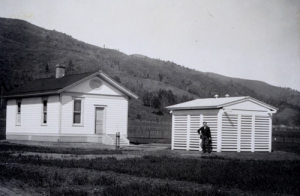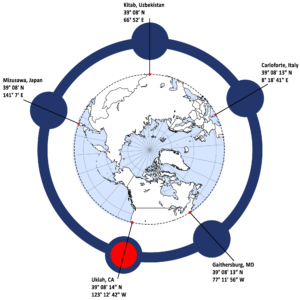
Observatory Park
Mendocino County’s Legacy in the World of Science
Landmarks are not frozen in time. They are not like prehistoric insects preserved in fossilized amber. They are living and their heritage is nurtured by community commitment and individual involvement.
In 2014 Observatory Park was dedicated to the people of Ukiah. From that day forward a commitment was made to preserve the Ukiah Latitude Observatory and for the park to become part of Ukiah’s living heritage.
Be a part of the heritage and come enjoy this unique park located at the 400 block of Observatory and Luce Avenues.
The International Latitude Observatories were a system of (originally) six observatories located near the parallel of 39° 08′ north latitude. They were used to measure the variation in latitude that occurs as a result of the “wobble” of the Earth on its polar axis.
United States Coast and Geodetic Survey joined the International Polar Motion Service program in 1897 to study the precession, or “wobble” of the Earth’s axis, and its effect on measures of latitude. Six separate observatories were created along the parallel 39° 08′ north latitude. The alignment of all six stations along the parallel helped the observatories to perform uniform data analysis.
Economic difficulties and war caused the closings of some of the original stations, though a newer station was created in Uzbekistan after World War I. The various stations continued to function until advances in computer technology and satellite observations rendered them obsolete in 1982. The data collected by the observatories over the years still has use to scientists, and has been applied to studies of polar motion, the physical properties of the Earth, climatology and satellite tracking and navigation.
Ukiah Latitude Observatory Was Built in 1899
The small size of the building (12 feet square) and the esoteric character of the work that took place within speak modestly of the international importance of the landmark. The research provided all data used in polar motion studies for decades, and fostered international cooperation which transcended the differences between man during times of war and international strain.
The city acquired the property in 1991 but the observatory and adjoining land was closed to the public until March 2014. A $54,000 grant from the California Land and Water Conservation Fund, along with matching funds from the City of Ukiah, made the improvements necessary to reopen the park.
A large heritage Valley Oak anchors the north end of the park. Spreading before it is a large grassy field providing an unobstructed view of the iconic tree.
Ukiah’s first Pétanque court was completed in 2010 for the game of boules, or balls, closely related to bocce by the Redwood Empire Boules Club.
A peace pole, dedicated to Erica Enzer, an international peace activist and former member of the Ukiah War Resistor’s League is located adjacent to the Grove of Nations (trees representing each of the regions where the latitude observatories were located).
The park has had improvements made before its public opening, including the restoration of the historic observatory and a labyrinth (pictured at left) installed in 2005.
The former observer’s residence has been used by Ukiah Unified School District since 2011 for the Community Transition Program which assists special needs students aged 18 to 22.
For more information about how you can become involved in preserving the Ukiah Latitude Observatory and our community’s cultural heritage, contact:
City of Ukiah
411 W. Clay St
Ukiah, CA 95482
(707) 463-6231
Observatory Park: Tours of Earth & Sky
Observatory Park is the home of the Ukiah Latitude Observatory, one of five international latitude observatories around the world operated from 1899 to 1982. The City of Ukiah offers several events associated with this unique park:
- Tours of Earth and Sky: Lecture series are held at the Ukiah Civic Center’s Council Chambers with guest speakers offering talks on astronomy and the natural sciences.
- Docent Tours of the Observatory and park are scheduled by appointment for small groups and individuals.
- Open Skies are scheduled periodically where amateur astronomers bring their telescopes, experience, and knowledge to explore the moon, planets, and deep sky wonders.
There is no charge for these events. Reservations are required and young children are welcome with a supervising adult. If you have questions, are interested in upcoming lectures, would like to schedule a tour, or are interested in finding out about the public viewing nights, call (707) 463-6231
News and Event Posts
 The Planet Walk at Observatory Park is a scale model of the solar system designed to fit within the boundaries of the walking path inside the park. Most people know that the planets orbit the Sun, but it is difficult to visualize just how small the planets are compared to the immensity of the Sun. It is equally difficult to imagine the vast empty spaces between the planets.
The Planet Walk at Observatory Park is a scale model of the solar system designed to fit within the boundaries of the walking path inside the park. Most people know that the planets orbit the Sun, but it is difficult to visualize just how small the planets are compared to the immensity of the Sun. It is equally difficult to imagine the vast empty spaces between the planets.
The Planet Walk is designed to give you a first-hand experience of the distance between the planets in a walkable scale. To accomplish this, the solar system is shrunk down so that the Sun is roughly the size of a lemon. This will make the Planet Walk small enough to include all eight planets and Pluto, because even though Pluto has been reclassified as a “dwarf planet”, we did not want to leave it out.
 To begin the Planet Walk, you will start at the sign representing the Sun on the north end (Luce Avenue side) of the walking path at Observatory Park. Follow the path counterclockwise to find markers representing each of the solar system’s planets. Each planet marker tells you approximately how many miles apart the planets are and the distance to scale.
To begin the Planet Walk, you will start at the sign representing the Sun on the north end (Luce Avenue side) of the walking path at Observatory Park. Follow the path counterclockwise to find markers representing each of the solar system’s planets. Each planet marker tells you approximately how many miles apart the planets are and the distance to scale.
The benefit of this project is a new community educational resource. The Planet Walk can be used for school field trips, giving a lot of kids a chance to walk past the planet markers and learn about the solar system, and it will also be a fun activity for any park user that is interested in the solar system.
To make your own walkable solar system use this free calculator from the Exploratorium. https://www.exploratorium.edu/explore/solar-system/activity/build-model
Thank you to the City of Ukiah for the opportunity to create this new community resource at Observatory Park.
 Project completed as an Eagle Scout Project for Troop 75 and led by Tyler Simerson.
Project completed as an Eagle Scout Project for Troop 75 and led by Tyler Simerson.
Below is a list of the Planet Walk information that can be found on the planet markers at Observatory Park using a scale of the Sun with a 2” diameter:
Sun
From the Sun to Mercury is approx. 36 million miles. (In this scale it is 6 feet.) Fun fact: The sun’s light takes 8 minutes to reach Earth!
Mercury
From Mercury to Venus is approx. 31 million miles. (In this scale it is 6 feet.) Fun fact: Closest planet to the Sun but still has ice!
Venus
From Venus to Earth is approx. 25.7 million miles. (In this scale it is 5 feet.) Fun fact: Venus doesn’t have any moons, and we aren’t sure why.
Earth
From Earth to Mars is approx. 48.6 million miles. (In this scale it is 10 feet.) Fun fact: Except for the Earth, the planets are named after gods from Roman and Greek mythology!
Mars
From Mars to Jupiter is approx. 342 million miles. (In this scale it is 66 feet.) Fun fact: Mars had a thicker atmosphere in the past.
Jupiter
From Jupiter to Saturn is approx. 401.5 million miles. (In this scale it is 77 feet.) Fun fact: You can see some of its moons from Earth with binoculars!
Saturn
From Saturn to Uranus is approx. 897 million miles. (In this scale it is 173 feet.) Fun fact: No one knows how old Saturn’s rings are!
Uranus
From Uranus to Neptune is approx. 1 billion miles. (In this scale it is 195 feet.) Fun fact: This is the coldest planet at around -371 degrees F.
Neptune
From Neptune to Pluto is approx. 881 million miles. (In this scale it is 170 feet.) Fun fact: Neptune has supersonic winds.
Pluto
Pluto is approx. 3,674.5 million miles from the Sun! (In this scale it is 708 feet.) Fun fact: Technically a dwarf planet, Pluto is 1/3 water.
Observatory Park Photo Gallery

















